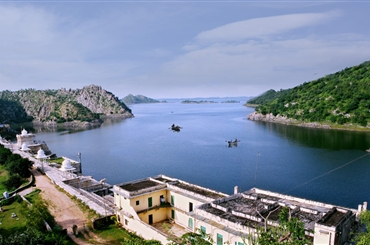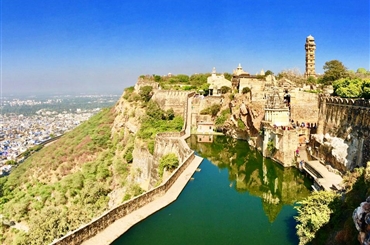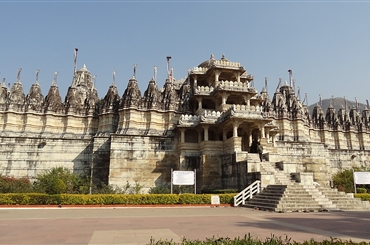
Jagdish Temple
Built by Maharana Jagat Singh in 1651, Jagdish Temple, situated within the Udaipur City Palace is another one of the great works of architecture from the olden days. It has finely carved pillars, beautifully decorated ceilings, gorgeously painted walls, and spacious halls and corridors. Apart from this, the architectural expertise also extends itself to the pyramidal spire, mandap (prayer hall) and the porch. There are 50 finely carved pillars, each on the first and the second floors of the three storey temple.

Jaisamand Lake
A stunningly situated artificial lake, built in the 17th century A.D. by Maharana Jai Singh is the second largest in Asia. Maharana Jai Singh at the time of foundation celebrated the occasion by giving away gold in charity after a Tuladaan ceremony. In the lake there are three islands whose inhabitants use Bhels (boats) to reach the shore. On the top of two nearby hillocks are two old palaces constructed by Maharana Jai Singh. A very fine view of the lake is available from these palaces. Graceful marble chhatris flank the embankment.

The Lake Palace
The Lake Palace in Udaipur is located on the Jag Niwas Island on a sprawling 1.5 hectare land. This magnificent structure was built on the Lake Pichola by Maharana Jagat Singh in 1734. Once a summer palace for the royalty of Udaipur, it has now been converted into a heritage hotel. Still retaining the grandeur, it resembles a fairy tale kingdom. Enhancing the magical aura are the rippling waves and beautiful sunset. The intricate craftsmanship and aesthetic handicrafts and textiles add to the beauty this place.

Gulab Bagh
Gulab Bagh, also known as Sajjan Niwas Garden, was built by Maharana Sajjan Singh in the 1881. It is the fourth oldest zoo in the semi-continent. It spans across 66 acres of land, and is hailed as one of the most beautiful and largest garden in Rajasthan. By Maharana's volition, a horticulturist from Madras, T.H. Story, was appointed in 1882 to stock the garden with plants with medicinal values on the 66.5 acres of land and worked there till 1920. Gulab Bagh is an old Sub-City Level Park, having lush green campus and several places of attraction including ponds, library, zoological park, temples and several government offices.

City palace
The City Palace in Udaipur in the state of Rajasthan has a lot in its store to reveal the age-old history it possesses. The royal building is a huge complex with plenty of rooms and pillars inside. It took more than 300 years to complete the structure properly. Started during the time of Maharana Udai Singh II. The lake Pichola nearby is the highlight when you get ready for a tour of the greatest places to visit in Udaipur. Since it is the biggest building in Udaipur it is considered as one of the best sightseeing destinations. The flamboyant structure with a blend of Mughal and Rajasthani architectural style dominates other famous palaces and buildings.

Jagmandir
Known as Lake Garden Palace, Jag Mandir has been built on the island of Lake Pichola. The construction of this structure has been credited to the three Maharanas of Mewar. This palace was started by the Maharana Amar Singh in the year of 1551 and was later carried on by Maharana Karan Singh and completed by Maharana Jagat Singh. Hence it is called Jagat Mandir or Jag Mandir. Serving as a summer resort and pleasure area for the royal family of Mewar, this place is also famous for holding parties and wedding functions. In here you will find Gul Mahal, Darikhana, Garden Courtyard, Bara Patharon ka Mahal, Zenana Mahal.

Ambrai Ghat
Ambrai Ghat or Manjhi Ghat is a main ghat situated near the waterfront of Lake Pichola in Udaipur. It is situated opposite to the Gangaur Ghat, near the Jagdish Chowk area. Ambrai Ghat is a popular for its lake-side location surrounded by many popular hotels including the Ambrai restaurant. It is also popular for the picturesque view of City Palace, Udaipur, and surrounding lakes.

Sajjangarh
Sitting on a hill just outside the main Udaipur city is the Monsoon Palace (Sajjangarh), undisputedly one of the best places to visit in Udaipur. The palace was built in 1884 by Maharana Sajjan Singh in order to be able to monitor the approaching monsoon clouds better. Monsoon Palace is a majestic piece of architecture. It is built with white marble and has light, wide corridors and rooms within. But the best thing about the palace is the view from its windows.

Maharana Pratap Memorial
This is one of the famous, low-key sites in Udaipur. The Maharana Pratap Memorial was built by Maharana Bhagwat Singh Mewar in memory of the legendary Maharana Pratap. The central figure of the memorial site is that of Maharana Pratap mounted on his horse and loyal friend, Chetak. The statue is symbolic because it tells a story of courage and faithfulness and deep love between humans and animals.

Saheliyon Ki Bari
Saheliyon ki Bari is a beautiful garden in the city of Udaipur and is one of the popular Udaipur tourist places. Fountains, marble art and the lush lawns attract the public each time. Saheliyon ki Bari in English means the ‘garden of maids’. This garden represents a green retreat of Maharana Sangram Singh in the desert lands and was built in the 18th Century for the royal ladies of Mewar. It is situated on the banks of the lake Fateh Sagar and is one of the stunning places to visit in Udaipur.

Shilpgram Fair
Shilpgram is a crafts fair and is organized annually in the west side of the city of Udaipur. It aims to promote the art, craft, textile and handicrafts of Rajasthan. This state is famous for handicrafts, bandhej, tie and dye, mirror work and embroideries. Camel leather items, hand woven clothes are some other items that are highlight of this fair. The gala is usually held during the month of November or December and continues for 10 days. This fair encourages local designers, potters.

Fateh Sagar Lake
The Fateh Sagar Lake is known to be the second largest lake in this city, is located on the northern side of Lake Pichola and is just opposite the entrance to Moti Magri Mahal. This artificial lake was built by Maharana Jai Singh in 1678 and got its name from Maharana Fateh Singh. This water body has a depth of 11.5 metres and extends 2.4 km in length and 1.6 km in breadth. There are three intake channels and one overflow channel in the lake that actually comes in play during the monsoon season.

Dudh Talai Musical Garden
Dudh Talai Musical Garden is a small pond surrounded by a rock garden which is supposed to have a musical fountain in it. This garden is situated within the city and you can easily stop by for 10 to 15 minutes. While the setting of the garden is good, the best part about it is the wide-ranging view visible from here. Lake Pichola is located nearby and you get to see the Udaipur City Palace at a very good angle from this point.

Lake Pichola
This is one of the most important places to visit in Udaipur. Lake Pichola is the reason we call Udaipur the ‘City of Lakes’. Built in 1362, and extending 3 miles in length and 2 miles in breadth, this lake is an essential part of Udaipur and far by its best feature. Astonished and amazed by the beauty of Lake Pichola, Rudyard Kipling once wrote: "If the Venetian owned the Pichola Lake, he might say with justice, `see it and die'".

Bagore Ki Haveli
Bagore ki haveli is a beautiful palace in Udaipur on the waterfront of Lake Pichola and is an amusing spot among the tourist places in Udaipur. It was built during the 18th century and still holds the pride and majestic attitude of the royal family of ancient rulers in a perfect manner. It consists of more than a hundred rooms along with the displays of costumes and modern art. It houses the famous paintings of the Mewar regime.

Badi Lake
Lake Badi, situated in Udaipur city in the Indian state of Rajasthan, is an artificial fresh water lake. The lake was built in the village of Badi, about 12 km from the city of Udaipur, by Maharana Raj Singh I (1652-1680) to counteract the devastating effects of a famine. He named it Jiyan Sagar after his mother Jana Devi. The lake covers an area of 155 km2., and has an embankment 180 m. long and 18 m. wide, which is graced by three artistic chhatris.

Chittorgarh
Chittorgarh is home to the Chittor Fort, the largest fort in India and Asia. It was the site of three major sieges (1303, 1535, and 1567–1568) by Muslim invaders, and its Hindu rulers fought fiercely to maintain their independence. On more than one occasion, when faced with a certain defeat, the men fought to death while the women committed suicide by jauhar (mass self-immolation). Chittor also has been a land of worship for Meera.

Ranakpur
Ranakpur is a village located in Desuri tehsil near Sadri town in the Pali district of Rajasthan in western India. It is located between Jodhpur and Udaipur. 162 km from Jodhpur and 91 km from Udaipur, in a valley on the western side of the Aravalli Range. The Nearest Railway Station to reach Ranakpur is Falna Railway station. Ranakpur is one among the most famous places to visit in Pali, Rajasthan. Ranakpur.

Haldighati
About 50 km from the city if Udaipur, Haldighati is a mountain pass in the hills of Aravali. The name comes from its yellow colour soil. It’s historically significant as the Battle of Haldighati, in 1576, was fought here between the army of the third Mughal emperor, Akhbar and the king of Mewar, Maharana Pratap Singh. One can visit the memorial of Chetak horse and Maharana Pratap Museum. It’s one of the most important places to visit near Udaipur for those who are interested in historical.

Chawand
From Jaisamand, one can go on to Chawand. After the reverse suffered at Haldighati, Maharana Pratap took to the jungles and a guerilla mode of warfare. It was during this phase that Pratap acquired Chawand and made it his capital in 1585. It has been noted that the architecture at Chawand reflects a spartan defense - consciousness. It is said that Pratap was cremated here in 1597 A.D. in the nearby village Bandoli, on the banks of a small stream.

Nagda
Nagda (anc. Naaghrida) was the old capital of Mewar. The chief relic, now extinct consists of the twin 'Saas - Bahu' temple of the 10th century. Spartan sanctums are here, wedded to sumptuous Mandaps, that of the bigger temple being more so. This latter in a closed one, richly carved both inside and outside, as compared to the open one in the other case. The group faces a large tank, the route to which is marked by a handsome torana or ceremonial gate.

Eklingji
The Eklingji Temple Complex is one of the architectural sights you need to put on your list of places to visit in Udaipur. It is a complex whose foundation dates back to 734 AD. The first temple of the complex was built back then by Bappa Rawal and dedicated to Eklingji. Eklingji is a form of Shiva and the complex is full of figurines of Shiva along with figurines of Parvati, Saraswati, Ganesh, Kartik and Nandi.

Nathdwara
When Auranagzeb embarked on a policy of wholesale destruction of Hindu temples, the custodians of the idol of Shrinathji of Govardhan, near Mathura, left that place with the idol in search of a new haven. While several other princes were diffident, it was Maharana Raj Singh of Mewar who dared to provide refuge. In 1672 Shrinathji was installed in a new temple built in village Sihad, now called Nathdwara, on the banks of the Banas.

Kumbhalgarh
Located about 85 km northwest of Udaipur in the middle of the wonderful Aravai hills, Kumbhalgarh Fort is considered the second most important forts of Rajasthan. There’s an impressive range of temples built by the Mauryas inside the fort. One must not skip Badal Mahal built inside the fort, which is also the most beautiful area of the fort. The magnificent views of the surroundings from Kumbhalgarh are feast for the eyes.
